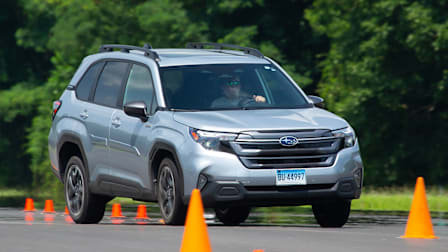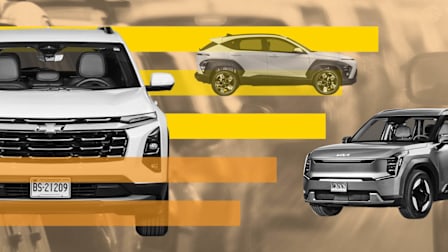CR’s Real-World EV Range Tests Show Which Models Beat EPA Estimates
Some electric cars from Ford, Lucid, and Tesla fell short, while others from BMW and Mercedes exceeded range expectations
The advertised ranges of many electric vehicles can vary significantly from the number of miles they can actually cover on a highway road trip, as testing by Consumer Reports shows. When driven at a constant highway speed of 70 mph, some vehicles we tested fell up to 50 miles short of their advertised ranges, while others exceeded their advertised ranges—one by more than 70 miles.
“Range is much more important when you’re far from home and away from reliable charging,” says Alex Knizek, associate director, auto test development, at CR. “If you run out of charge on the highway, you may need to be towed, which could be both inconvenient and costly.”

Photo: Mike Crossen/Consumer Reports Photo: Mike Crossen/Consumer Reports
Our Findings
Of the 30 EVs we have tested so far, more than half fell short of their EPA-estimated ranges when driven at highway speeds. We are continuing to evaluate highway range for every EV we test, and will post the results here as soon as they are available.
Although most vehicles that fell short only missed their EPA estimates by a handful of miles, we found the biggest difference in range with the Ford F-150 Lightning pickup truck: Its battery ran out after just 270 miles—a 50-mile difference from the EPA estimate.
A few luxury sedans also fell short: Our Lucid Air missed its advertised 377-mile range by 40 miles. The Tesla Model S has an EPA range of 410 miles, but we measured only 366 miles of highway driving.
On the other hand, some BMW and Mercedes-Benz vehicles beat their EPA-estimated ranges by more than 40 miles. Our Cadillac Lyriq also exceeded EPA estimates at highway speeds.
“Those extra miles can be a benefit for those who need to drive in cold weather or utilize some of the blistering fast acceleration that EVs provide, both of which can cut range considerably,” Fisher says.
For more details on how our test models were equipped, as well as more test results, visit their model pages.

The difference between EPA range and our highway tests is largely due to how the EPA tests EVs, says Chris Harto, senior energy policy analyst at CR.
“EPA’s testing procedures date back to the early days of EVs, and what’s included on the window sticker is partially controlled by laws written decades ago for gas cars,” he says. “CR has asked EPA to start the process of modernizing these regulations to help provide more useful consumer information about today’s EVs, including highway range." In 2024, the EPA told us that the agency is continuing to evaluate its methods and procedures for determining EV range.
How We Test EV Highway Range
To ensure the vehicle is properly broken in and still has full battery capacity, we only test cars we own with between 2,000 and 15,000 miles on the odometer. (Some vehicles from automakers, including Chevrolet, Nissan, Polestar, Rivian, and Tesla are not represented because we do not currently own them, they did not meet all of our testing criteria, or we simply haven’t tested them yet.)
Beyond mileage, we also inspect tires for additional wear, which can affect range. And as always, all tested vehicles were purchased anonymously from local dealerships and vehicle manufacturers.
Because driving in the cold and running the heater can shorten an EV’s range between 25 and 50 percent, we perform all our range tests in summer at temperatures between 70 and 90° F and when the weather is clear, which is the most favorable for EV range. If we purchase a new vehicle at another time of the year, we will initially score it based on its EPA range until we can perform our own tests.
We control the tests in other ways as well, setting tire pressure to factory specifications, preconditioning the vehicles inside our garage, setting climate control to 72° F, and using cruise control with speed and mileage verified via GPS. To better understand what drivers experience when range gets critically low, we also document what warnings the vehicles provide. We set regenerative braking to the lowest level, and we also test vehicles in Eco mode, if the car has it, to maximize range the way drivers would likely do on a road trip. If there’s a significant slowdown on our route, we restart the test.
EV Charging and Performance Scores
In addition to the highway test, our evaluations also reflect how EVs perform in real-world driving. Since we live with the EVs we purchase for our testing program, we know what it’s like to plug in our EVs every night or at public chargers on a road trip.
For example, we evaluate the speed of charging in two ways: The maximum miles of range you can add per hour of Level 2 charging, and the peak miles of range you can add per minute of DC fast charging under ideal conditions. Most Level 2 charging takes place at home or work—overnight or while you’re at the office. By comparison, most DC fast charging takes place on longer trips, when you’d rather be on the road than waiting at a charger, so we give more weight to quick DC fast charging than to Level 2 charging. This score also gives an advantage to more energy-efficient vehicles, which can go more miles per charge.
“This information allows shoppers to compare the unique characteristics of EVs and what it’s like to live with them every day,” Fisher says.

Photo: John Powers/Consumer Reports Photo: John Powers/Consumer Reports
On our vehicle model pages, we also indicate each vehicle’s charging speed for a variety of chargers. A car might be capable of super-fast charging, but if you don’t have access to a 350-kilowatt charger, we can also tell you the charging speed you will get at slower and more common chargers.
“The size of the charger or how quickly a battery goes from 20 percent to 80 percent charged is only part of the equation,” Knizek says. “How quickly you can add miles is what matters most.” The top-scoring vehicles are those that charge quickly but are also very efficient.
Our charging scores also take into account how easy an EV is to plug in and unplug, and whether it comes with any built-in features, such as navigation, that make charging easier.
“You’re probably interacting with the charge port a lot more often than you would fill up a gas car,” Fisher says.
For example, Rivians have plugs that are low to the ground and feature a hidden switch, while Teslas are much easier to plug in with just one hand. Tesla and Rivian both shine with full-featured smartphone apps and navigation routing designed to minimize time spent finding chargers and plugging in.
As part of an EV’s transmission score, we score the ease of one-pedal driving, which allows the driver to speed up or slow down by using only the accelerator pedal. For EV road-test scores, we also gave our acceleration test results less weight because most EVs offer blazing-fast acceleration that’s impractical for public roads. “Not everyone will take their EV to a drag strip, but everyone plugs it in,” Fisher says.
Editor’s Note: This article was updated on June 3, 2025 to add new vehicle data.





















